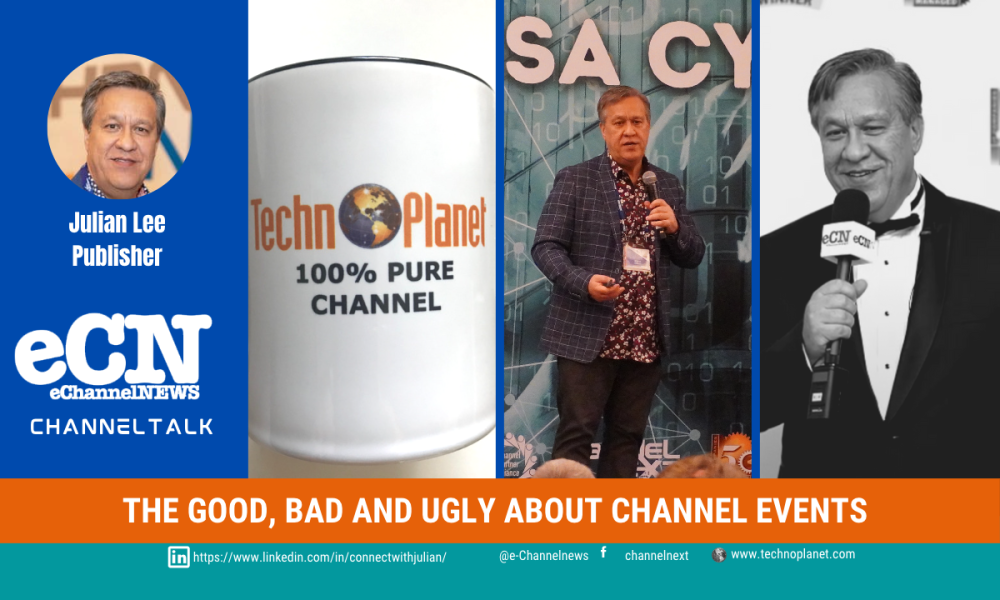
Approximately 300 IT channel events take place each year across North America. I know of some vendors that exhibit in over 50 events per year. Some reps are on the road for over 200 days.
There is no shortage of channel events to attend!
Pre-pandemic, in-person events were the primary activity in the channel partner recruitment playbook. Today, that playbook has transformed because of the digital-first economy. As a matter of fact, the way we build channel partnerships continues to morph as we accelerate into more comprehensive and inclusive ecosystems where partner transactions no longer rule.
If you are not up to speed on this future, then you need to catch up before you are left behind. We are constantly adapting as the next new normal unfolds and in case you think we are already in the new normal, think again as advancements in AI will change the game in ways we still do not know!
For this article, I wanted to focus on some channel event trends that we are seeing post-pandemic and get your feedback.
The entire event experience remains the most important benchmark for attendees. Content is mission critical.
People want less sales pitches and deeper education. They want to be surprised and hopefully learn something important they did not know. They want less talking-heads and more peer-to-peer collaboration. They want to listen to “experts” who actually understand their business and needs. They want to spend less time traveling to and from events. There is even a trend away from too much partying and drinking. Diversity and zero tolerance for sexual harassment is a requirement. They want easy ways to share content. They want both in-person and virtual events. They want less SWAG and more sustainability.
The feedback we get indicates that today, the average MSP attends less than 3 in-person events per year. However, they would also like access to the content for events that they do not attend to view on-demand.
With ongoing challenges in hiring and retaining staff, there are simply less humans available to attend events and in case you haven’t noticed, everything costs a lot more. One MSP commented to me that he no longer sends his reps to events because they get head-hunted by either vendors or other MSPs (when you think about it, events can be a good employee hunting ground).
If there was one takeaway from this article, it’s that everyone should attend more targeted in-person events, especially if they are hosted in their own local area. Staying at home or zooming has its advantages and place, but interacting with other humans is essential for business and mental fitness. Remember, you never know what you’ll discover at any event, so go with an open mind.
Channel events can be broken down into five basic categories:
- Vendor Partner Events: These are events where a vendor hosts an event for their partners and invites other vendors to exhibit in order to subsidize costs and attract their partners to increase attendance. In theory, this seems like a good idea (certainly for the organizing vendor), but the event could eventually become a huge poaching ground for competitors. If you don’t understand what this means, it’s because you haven’t figured it out yet. This disadvantage can be detrimental to your company in the long run. Because of third-party vendor funding and support, these events can gain tremendous traction to the point where they no longer require any one vendor. So, if you don’t keep paying to play, they’ll turn to your competitors to come in and recruit the partners you helped them build. That said, some of these events make a lot of sense to attend and be part of their ecosystem!
- Distributor Events: These have existed since the beginning of the channel, and when we were in the distribution business, we hosted some of the most incredible events with thousands of attendees. Vendors on the line-card would pay for everything and distributors do profit handsomely. The disadvantage is that most distributors only care about the money. We all know that most distributors’ marketing value delivers a fraction on the dollar because it’s a huge profit center. If you are doing a lot of business with a distributor, then you will want to attend their events!
- News Media Events: For several reasons, news media events may be the most valuable for vendors, partners, and distributors. They are independent and objective and you also generate news coverage. On neutral ground, you are free to discover new opportunities. Content is usually much better when it comes from news media sources. They also have a subscription base that is constantly being educated about trends, products, and business tips, among other things. News media can also amplify your message to a much wider audience beyond the attendees of any event. Our own survey of our channel partner subscribers indicates that 73% learn about new products from news media outlets and may be one reason why our news media eChannelNEWS continues to grow fast.
- Third-Party Event Organizations: These events can be hit or miss and only exist due to demand. Their goal is to cram as many exhibitors and attendees as possible into the space available, and they will even sell attendee lists to anyone. They take advantage of all parties because that is their business model. This works much better for end-user events and much less for channel events. To gain momentum, they try to stitch together several market segments and it just ends up being a frankenstein with a mix of channel and end-users.
- Community Events: Various communities and groups host events for their members and invite partner vendors to exhibit. These are excellent events because they bring the members together. The disadvantage is that you meet roughly the same people year after year, which can get stale and don’t generate much growth. Having said that, maintaining visibility within the group has value. The disadvantage is that community organizers can easily bring in competitors to steal your business and group organizers are also taking some percentage of profits away from their members. Eventually, most buying groups’ communities may fade away as transactional partners become less valued by vendors. That said, community run events do work.
Smart channel events are focused on a specific target market and audience. They host more local events to reduce travel time and costs for attendees. They host speakers who understand the topics as well as the channel community. Events that facilitate more effective peer-to-peer collaboration are also on the rise.
Measuring ROI from today’s events:
The majority of event exhibitors are challenged in measuring ROI. We created an e-guide on this topic (request a free copy). Event managers focus way too much on how many people will be attending the event instead of quality. They rarely inquire about the content and speakers, but they should. Many send a sales representative (sometimes a rookie) with a booth and some swag. Their bottom line ROI measurement seems to be how many leads or contacts the rep brings back to feed into their marketing machine so they can keep on drip marketing. Sadly, most salespeople do not even follow up with prospects they met at the event because they are already on to the next.
Event managers need to think bigger, deeper and wider. The total cost of the event versus the total value generated from pre, during and post event! This is one way the news media organized events deliver much more value. In some cases the news media coverage is worth more than the exhibitor cost of the event.
I have one last message for channel partners on events.
If you register for an event, you should show up unless there is a really good reason. First, make sure you register and come for the right reason. Do your research to select the appropriate events.
No-shows are bad for the event industry. It obviously bad for the sponsors who spend money and send staff to meet you. It’s also bad for the environment with the waste of food (and SWAG); and obviously bad for the organizer who will be forced to move to other markets to attract attendees and sponsors.
While one person may not believe their impact will be significant, the multiplier effect when a significant percentage does not show can be disastrous. Today, it appears that the number of no-shows is less predictable. Maybe it’s a post pandemic phenomenon as I was told when the pandemic just hit everyone was saying I need to get out and meet people. Now, post pandemic, people are saying why would I want to leave my home. Seems like there was a seismic shift in the comfort zones of people?
So, if you want great channel events to keep coming to your area to help you grow your business, put on your shoes and come in-person to support them.
Please make every effort to attend ANY event you register for, free or not, ours or not. If you are unsure whether the event is right for you, don’t register. At the very least, please cancel your registration at least two weeks in advance so that organizers can adjust requirements and expectations for everyone.
Have a great show wherever you go!

